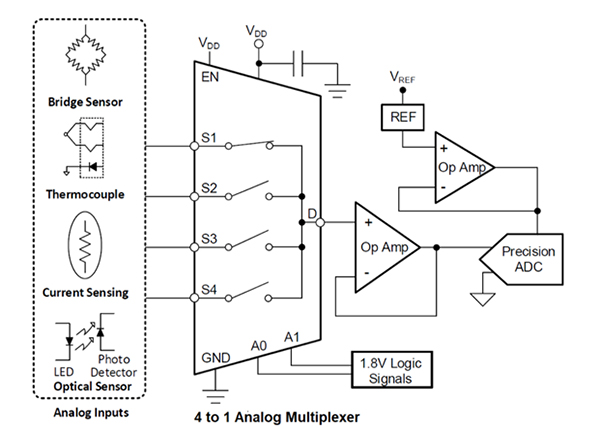In the realm of electronic systems, the efficient management and transmission of signals are paramount. Analog multiplexers stand as stalwart components in this endeavor, facilitating the seamless transmission of multiple analogue signals over a single channel. This article delves into the intricacies of analogue multiplexers, exploring their functionality, differences from digital counterparts, bidirectional capabilities, and real-world applications.
What is an Analog Multiplexer?
At its core, an analog multiplexer is a pivotal electronic device designed to route multiple analog signals through a single channel. It operates on the principle of time-division multiplexing (TDM), where signals are sequentially sampled and transmitted in discrete time slots. Analog multiplexers typically consist of an array of switches or transistors that selectively route analogue signals based on control signals.
These multiplexers find extensive use in various applications, including telecommunications, instrumentation, data acquisition systems, and audio processing. By consolidating multiple signals into a single channel, analog multiplexers streamline signal transmission, conserve resources, and enhance system efficiency. Helpful resource: https://toshiba.semicon-storage.com/ap-en/semiconductor/knowledge/e-learning/cmos-logic-basics/chap3/chap3-2-6.html

What is the Difference Between Analog and Digital Multiplexing?
While both analog and digital multiplexing techniques serve the purpose of combining multiple signals into a single transmission medium, they differ fundamentally in their signal representation and processing.
Analog multiplexing involves the direct manipulation and transmission of continuous, variable signals. It operates in the domain of analogue voltages or currents, retaining the fidelity of the original signals throughout the multiplexing process. In contrast, digital multiplexing deals with discrete, binary signals represented as sequences of ones and zeros. It entails the conversion of analogue signals into digital format through sampling and quantization before multiplexing.
The key distinction lies in the handling of signal continuity and resolution. Analog multiplexers preserve the continuous nature of analogue signals, making them suitable for applications where signal integrity is paramount. Conversely, digital multiplexers excel in scenarios requiring precise signal quantization, processing, and error correction. Helpful resource: https://eatelier.nl/?e_component=multiplexer
Are Analog Multiplexers Bidirectional?
One common query regarding analog multiplexers pertains to their bidirectional capabilities. Unlike digital multiplexers, which often feature separate input and output channels, analog multiplexers typically exhibit bidirectional functionality.
The bidirectional nature of analog multiplexers allows for seamless switching and transmission of signals in both directions along the same channel. This versatility is particularly advantageous in applications such as audio routing, where signals may flow bidirectionally between input and output devices.
Moreover, bidirectional analog multiplexers simplify system design and reduce component count by consolidating both input and output functionalities within a single device. This characteristic underscores their versatility and suitability for diverse signal routing applications.
What is an Example of a Multiplexer?
To illustrate the practical application of analog multiplexers, consider the scenario of a temperature monitoring system in an industrial setting. This system comprises multiple temperature sensors distributed across different locations, each generating analogue signals corresponding to the measured temperature.
By employing an analog multiplexer, these analogue signals can be sequentially sampled and transmitted to a centralized data acquisition unit through a single communication channel. The multiplexer sequentially selects each sensor's output and routes it to the data acquisition system, where the temperature readings are recorded and analyzed.
In this example, the analog multiplexer serves as a crucial component in streamlining signal acquisition and transmission, enabling efficient monitoring and control of temperature variations across the industrial environment. Helpful resource: https://www.electronicshub.org/multiplexer-and-demultiplexer/
Conclusion
Analog multiplexers represent indispensable tools in the realm of signal processing and transmission, offering a versatile solution for consolidating multiple analogue signals into a single channel. Understanding their functionality, differences from digital counterparts, bidirectional capabilities, and real-world applications is essential for harnessing their full potential in diverse electronic systems. Whether in telecommunications, instrumentation, or audio processing, analog multiplexers continue to play a pivotal role in optimizing signal routing and enhancing system efficiency.
Facts Checked by Hugh Johnson
Hugh Johnson stands tall in the realms of both the Integrated Circuits (ic Chips) industry and the electronic parts industry, earning acclaim as an esteemed expert in these fields. With an extensive background steeped in semiconductor technology, Hugh's expertise transcends chip design and fabrication, encompassing a profound understanding of electronic components' intricate functionalities and applications. His seasoned knowledge spans diverse facets, from microchip architecture and fabrication techniques to the broader landscape of electronic parts utilized across industries.









